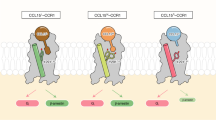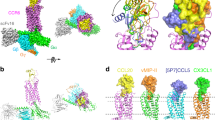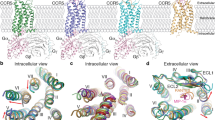Abstract
FROUNT is a cytoplasmic protein that binds to the membrane-proximal C-terminal regions (Pro-Cs) of chemokine receptors, CCR2 and CCR5. The FROUNT–chemokine receptor interactions play a pivotal role in the migration of inflammatory immune cells, indicating the potential of FROUNT as a drug target for inflammatory diseases. To provide the foundation for drug development, structural information of the Pro-C binding region of FROUNT is desired. Here, we defined the novel structural domain (FNT-CB), which mediates the interaction with the chemokine receptors. A recombinant GST-tag-fused FNT-CB protein expression system was constructed. The protein was purified by affinity chromatography and then subjected to in-gel protease digestion of the GST-tag. The released FNT-CB was further purified by anion-exchange and size-exclusion chromatography. Purified FNT-CB adopts a helical structure, as indicated by CD. NMR line-broadening indicated that weak aggregation occurred at sub-millimolar concentrations, but the line-broadening was mitigated by using a deuterated sample in concert with transverse relaxation-optimized spectroscopy. The specific binding of FNT-CB to CCR2 Pro-C was confirmed by the fluorescence-based assay. The improved NMR spectral quality and the retained functional activity of FNT-CB support the feasibility of further structural and functional studies targeted at the anti-inflammatory drug development.







Similar content being viewed by others
References
Rosenbaum, D. M., Rasmussen, S. G. F., & Kobilka, B. K. (2009). The structure and function of G-protein-coupled receptors. Nature, 459(7245), 356–363. doi:10.1038/nature08144.
Charo, I. F., Myers, S. J., Herman, A., Franci, C., Connolly, A. J., & Coughlin, S. R. (1994). Molecular cloning and functional expression of two monocyte chemoattractant protein 1 receptors reveals alternative splicing of the carboxyl-terminal tails. Proceedings of the National Academy of Sciences of the United States of America, 91(7), 2752–2756.
Kraft, K., Olbrich, H., Majoul, I., Mack, M., Proudfoot, A., & Oppermann, M. (2001). Characterization of sequence determinants within the carboxyl-terminal domain of chemokine receptor CCR5 that regulate signaling and receptor internalization. The Journal of biological chemistry, 276(37), 34408–34418. doi:10.1074/jbc.M102782200.
Terashima, Y., Onai, N., Murai, M., Enomoto, M., Poonpiriya, V., Hamada, T., et al. (2005). Pivotal function for cytoplasmic protein FROUNT in CCR2-mediated monocyte chemotaxis. Nature Immunology, 6(8), 827–835. doi:10.1038/ni1222.
Toda, E., Terashima, Y., Sato, T., Hirose, K., Kanegasaki, S., & Matsushima, K. (2009). FROUNT is a common regulator of CCR2 and CCR5 signaling to control directional migration. Journal of Immunology, 183(10), 6387–6394. doi:10.4049/jimmunol.0803469.
Belema-Bedada, F., Uchida, S., Martire, A., Kostin, S., & Braun, T. (2008). Efficient homing of multipotent adult mesenchymal stem cells depends on FROUNT-mediated clustering of CCR2. Cell Stem Cell, 2(6), 566–575. doi:10.1016/j.stem.2008.03.003.
Satoh, M., Akatsu, T., Ishkawa, Y., Minami, Y., & Nakamura, M. (2007). A novel activator of C–C chemokine, FROUNT, is expressed with C–C chemokine receptor 2 and its ligand in failing human heart. Journal of Cardiac Failure, 13(2), 114–119. doi:10.1016/j.cardfail.2006.11.003.
van Golen, K. L., Ying, C., Sequeira, L., Dubyk, C. W., Reisenberger, T., Chinnaiyan, A. M., et al. (2008). CCL2 induces prostate cancer transendothelial cell migration via activation of the small GTPase Rac. Journal of Cell Biochemistry, 104(5), 1587–1597. doi:10.1002/jcb.21652.
Toda, E., Terashima, Y., Esaki, K., Yoshinaga, S., Sugihara, M., Kofuku, Y., et al. (2014). Identification of a binding element for the cytoplasmic regulator FROUNT in the membrane-proximal carboxy-terminal region of chemokine receptors CCR2 and CCR5. Biochemical Journal, 457(2), 313–322. doi:10.1042/BJ20130827.
Esaki, K., Yoshinaga, S., Tsuji, T., Toda, E., Terashima, Y., Saitoh, T., et al. (2014). Structural basis for the binding of the membrane-proximal C-terminal region of chemokine receptor CCR2 with the cytosolic regulator FROUNT. The FEBS Journal, 281(24), 5552–5566. doi:10.1111/febs.13096.
Sreerama, N., & Woody, R. W. (2000). Estimation of protein secondary structure from circular dichroism spectra: comparison of CONTIN, SELCON, and CDSSTR methods with an expanded reference set. Analytical Biochemistry, 287(2), 252–260. doi:10.1006/abio.2000.4880.
Pervushin, K., Riek, R., Wider, G., & Wüthrich, K. (1997). Attenuated T2 relaxation by mutual cancellation of dipole-dipole coupling and chemical shift anisotropy indicates an avenue to NMR structures of very large biological macromolecules in solution. Proceedings of the National Academy of Sciences of the United States of America, 94(23), 12366–12371.
Mathis, G. (1995). Probing molecular interactions with homogeneous techniques based on rare earth cryptates and fluorescence energy transfer. Clinical Chemistry, 41(9), 1391–1397.
Letunic, I., Doerks, T., & Bork, P. (2015). SMART: recent updates, new developments and status in 2015. Nucleic Acids Research, 43, D257–D260. doi:10.1093/nar/gku949.
Boratyn, G. M., Camacho, C., Cooper, P. S., Coulouris, G., Fong, A., Ma, N., et al. (2013). BLAST: a more efficient report with usability improvements. Nucleic Acids Research, 41, W29–W33. doi:10.1093/nar/gkt282.
Buchan, D. W. A., Minneci, F., Nugent, T. C. O., Bryson, K., & Jones, D. T. (2013). Scalable web services for the PSIPRED Protein Analysis Workbench. Nucleic Acids Research, 41, W349–W357. doi:10.1093/nar/gkt381.
Gardner, K. H., & Kay, L. E. (1998). The use of 2H, 13C, 15N multidimensional NMR to study the structure and dynamics of proteins. Annual Review of Biophysics and Biomolecular Structure, 27, 357–406. doi:10.1146/annurev.biophys.27.1.357.
Acknowledgements
We are grateful to Dr. Shogo Misumi for the MALDI/TOF MS measurements. This work was supported in part by the Targeted Proteins Research Program (TPRP) from the Ministry of Education, Culture, Sports, Science and Technology of Japan (MEXT) (to S.Y., E.T., Y.T., K.M. and H.T.), by Practical Research for Innovative Cancer Control from the Japan Agency for Medical Research and Development (AMED) (to S.Y., E.T., Y.T., K.M. and H.T.), by Project for Development of Innovative Research on Cancer Therapeutics (P-DIRECT) from AMED (to S.Y., M.T., Y.T., K.M. and H.T.), by a Grant-in-Aid for Young Scientists (B) (JP19790064) from MEXT (to S.Y.), by the KUMAYAKU Alumni Research Fund (to S.Y.), by a Sasakawa Scientific Research Grant from the Japan Science Society (to K.Y.), by the Global COE Program-Cell Fate Regulation Research and Education Unit from MEXT (to K.Y.), by the Adaptable and Seamless Technology Transfer Program through target-driven R & D (A-STEP), Japan Science and Technology Agency (JST) (to H.T.) and by the Cooperative Research Project Program of the Medical Institute of Bioregulation, Kyushu University (to H.T.).
Author information
Authors and Affiliations
Corresponding author
Rights and permissions
About this article
Cite this article
Sonoda, A., Yoshinaga, S., Yunoki, K. et al. Identification and Preparation of a Novel Chemokine Receptor-Binding Domain in the Cytoplasmic Regulator FROUNT. Mol Biotechnol 59, 141–150 (2017). https://doi.org/10.1007/s12033-017-0002-2
Published:
Issue Date:
DOI: https://doi.org/10.1007/s12033-017-0002-2




